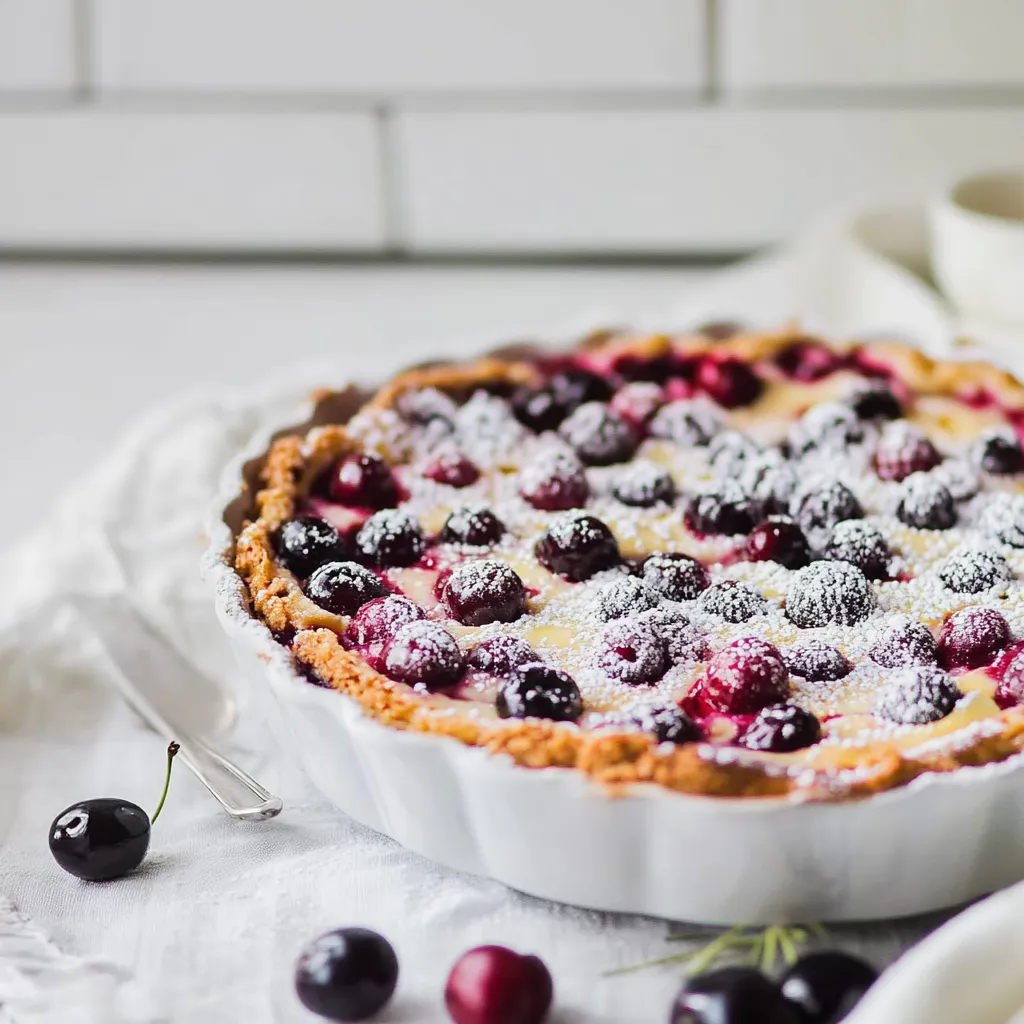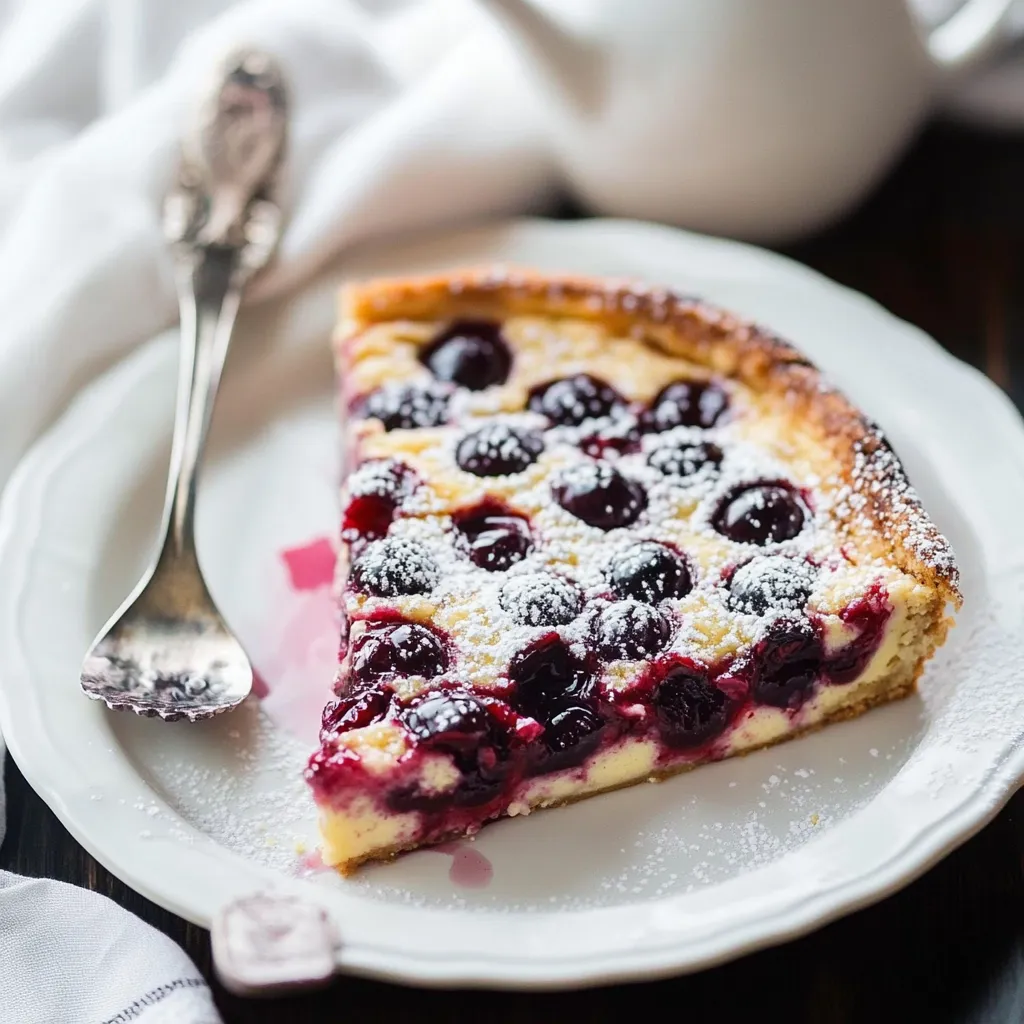 Bookmark
Bookmark
This rustic mini cherry clafoutis recipe transforms simple ingredients into an elegant French dessert that's surprisingly easy to make. The contrast between the sweet-tart cherries and the custardy batter creates a perfect balance that works for breakfast, brunch, or dessert.
I first made these mini clafoutis when hosting a French-themed dinner party. The simplicity of preparation combined with the impressive presentation had my guests thinking I'd spent hours in the kitchen when it really took less than 15 minutes of active time.
Ingredients
- Fresh cherries provide bursts of sweet-tart flavor and beautiful color. Look for firm, plump fruits with glossy skin and green stems.
- All-purpose flour gives structure to the custard without making it heavy. Measure by spooning into the cup and leveling for best results.
- Granulated sugar balances the tartness of the cherries. The amount can be adjusted based on the sweetness of your fruit.
- Large eggs create the custardy texture. Room temperature eggs incorporate better into the batter.
- Whole milk contributes richness. The fat content is important for the silky texture of the final dish.
- Vanilla extract enhances the flavor of both the cherries and the custard. Pure extract offers the best flavor.
- Salt brings out the sweetness and balances the flavors. Even a small amount makes a big difference.
- Powdered sugar adds a beautiful finishing touch and subtle sweetness. Apply just before serving for the best presentation.
Step-by-Step Instructions
- Prep the Oven and Dish
- Heat your oven to exactly 350°F ensuring proper rise and texture. Use butter to thoroughly grease a 9-inch pie dish, making sure to coat the sides well to prevent sticking. The butter also adds a subtle richness to the edges of the clafoutis.
- Arrange the Cherries
- Place pitted cherries in a single layer across the bottom of the greased dish. Distribute them evenly to ensure each serving has plenty of fruit. Traditional French recipes actually keep the pits in for flavor, but removing them makes eating more enjoyable.
- Make the Batter Base
- Whisk the flour and sugar together until completely combined with no lumps. This ensures the sweetness is evenly distributed throughout the finished dessert. The mixture should look like fine sand when properly combined.
- Incorporate the Eggs
- Add eggs one at a time, whisking vigorously after each addition until fully incorporated. This method creates a smoother batter and helps build the proper structure. You'll notice the mixture becoming increasingly pale and slightly thicker with each egg.
- Finish the Batter
- Pour in the milk gradually while continuously whisking to prevent lumps from forming. Add the vanilla extract and salt, then whisk until the batter becomes smooth and somewhat thin, similar to crepe batter. The consistency should be pourable but not watery.
- Combine and Bake
- Pour the batter carefully over the arranged cherries, allowing it to settle evenly around the fruit. Some cherries may float which creates a beautiful effect in the finished dessert. Bake until the edges are golden brown and puffed while the center is just set but still slightly jiggly, about 45-50 minutes.
- Serve Warm
- Allow the clafoutis to cool slightly for 10-15 minutes as it will be too hot to enjoy immediately. Dust generously with powdered sugar just before serving for both flavor and visual appeal. The contrast between the warm dessert and cool topping is particularly delightful.
 Bookmark
Bookmark
My grandmother taught me to make clafoutis using cherries from her backyard tree in Provence. She always left the pits in and warned us before serving, claiming the slight inconvenience was worth the enhanced flavor. While I pit them for guests, I sometimes leave them in when making it just for family as a nod to tradition.
Seasonal Adaptations
While cherries are the traditional choice for clafoutis, this versatile recipe works beautifully with many seasonal fruits. Try blackberries or blueberries in summer, sliced pears or apples in fall, or even frozen fruit year-round. The baking time remains consistent regardless of the fruit used, though very juicy options may need an extra 5 minutes in the oven.
Making Ahead and Storage
Clafoutis is best enjoyed the day it's made, preferably while still slightly warm. However, leftovers can be covered and refrigerated for up to 2 days. To refresh, bring to room temperature or warm briefly in a 300°F oven for 10 minutes. Avoid microwaving as it can create a rubbery texture in the custard. I don't recommend freezing clafoutis as the texture significantly deteriorates.
The French Connection
Clafoutis originated in the Limousin region of France as a way to showcase the area's famous black cherries. Traditionally served as a dessert, many French families also enjoy it for breakfast or as an afternoon treat with coffee. The name comes from the Occitan word "clafir," meaning "to fill," referencing how the cherries fill the batter. In some regions of France, clafoutis made with fruits other than cherries is called "flaugnarde."
Recipe FAQs
- → Can I use frozen cherries instead of fresh?
Yes, frozen cherries work well in this clafoutis. Thaw them completely and drain excess liquid before using to prevent the dessert from becoming too watery. Pat them dry with paper towels for best results.
- → Is it necessary to pit the cherries?
While traditional French clafoutis often leaves the pits in (supposedly for flavor), pitting the cherries makes eating the dessert much more enjoyable. If you don't have a cherry pitter, you can use a paperclip or pastry tip to remove them.
- → Can I make this with other fruits?
Absolutely! While cherries are traditional, you can substitute berries, sliced peaches, plums, or apricots. Technically, when made with fruit other than cherries, it's called a 'flaugnarde' in France, but the preparation is identical.
- → Why did my clafoutis sink in the middle?
Clafoutis naturally puffs up during baking and then settles as it cools - this is completely normal. The finished texture should be somewhere between a custard and a cake, slightly firm around the edges and tender in the center.
- → How do I know when my clafoutis is done?
A properly baked clafoutis should be set and golden on top, with a slight jiggle in the center when gently shaken. You can also test by inserting a knife in the center - it should come out clean but moist.
- → Can I prepare the batter ahead of time?
Yes, you can prepare the batter up to 24 hours in advance and refrigerate it in a covered container. Give it a gentle whisk before pouring over the cherries when you're ready to bake.
